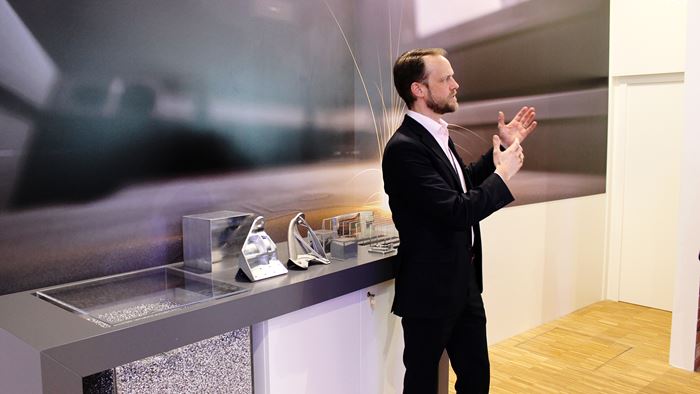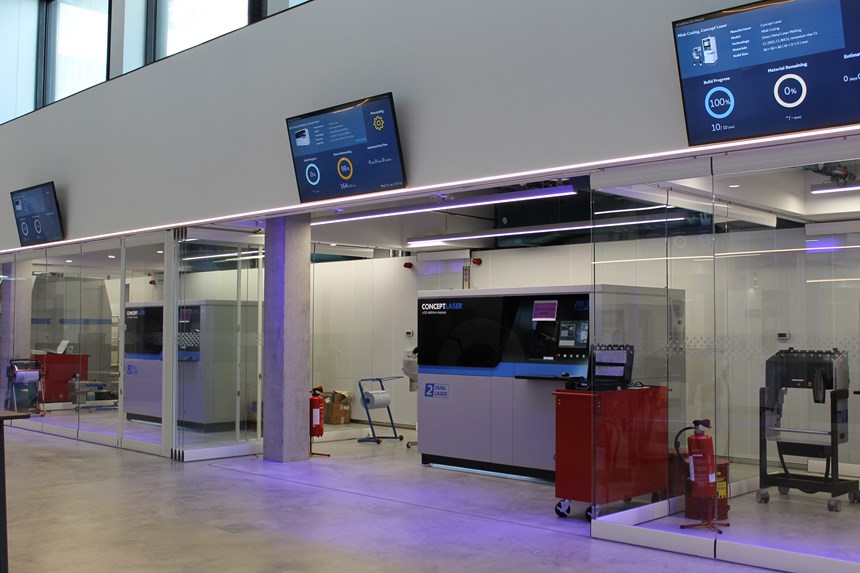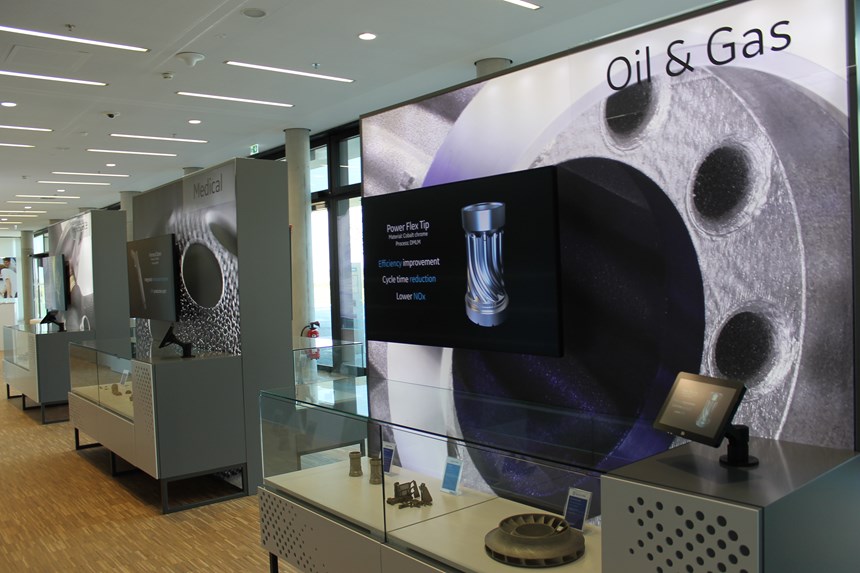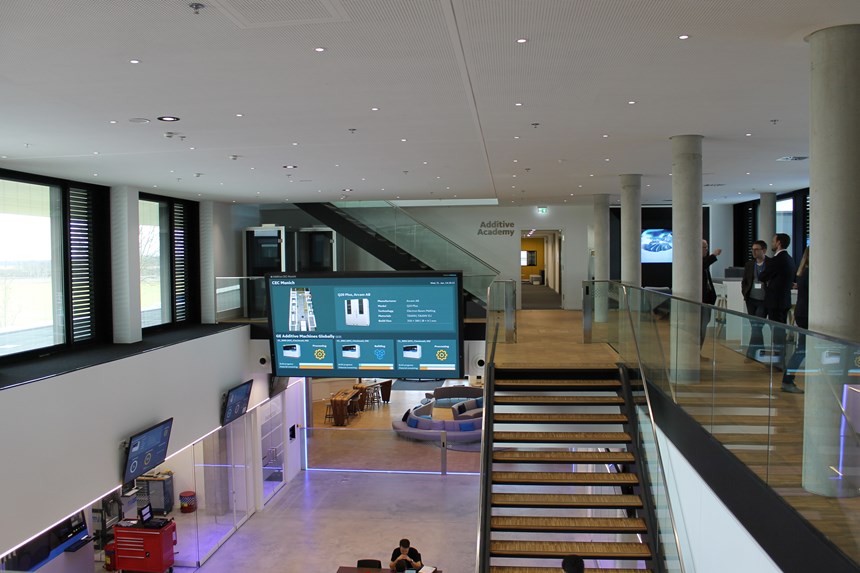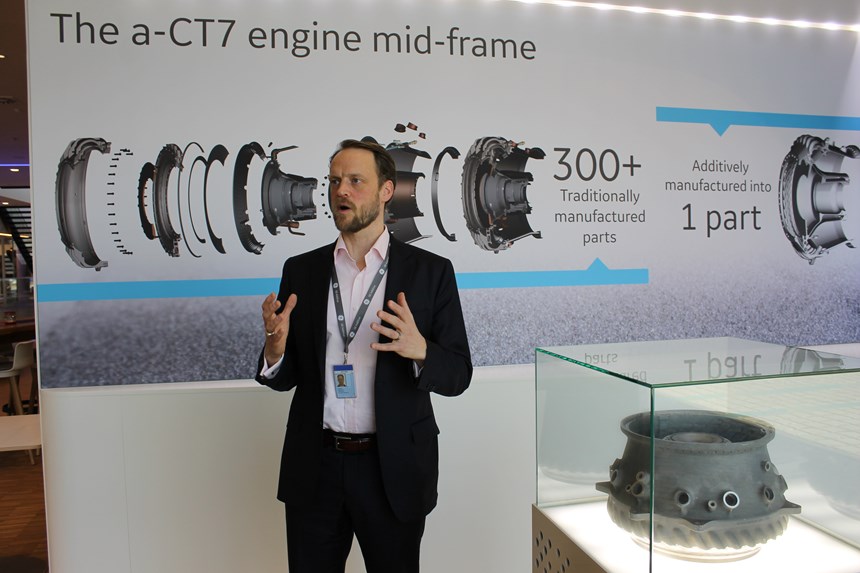A Journey through Additive at GE's Customer Experience Center
Additive Manufacturing’s Field of Dreams: GE’s new Customer Experience Center aims to accelerate AM’s adoption around the world.
One way of illustrating this pivotal moment in history for additive manufacturing (AM) is to consider the central irony of GE’s new Customer Experience Center (CEC) in Munich, Germany. Inside this gleaming 2,700-square-foot facility, which opened its doors for business just this past December, teams of engineers and technicians are educating both themselves and their first customers on all aspects of GE Additive’s core technologies. As both a concept and a facility, the new CEC plays a unique role in GE Additive’s universe, and the company’s $15 million investment in this center is a testament to GE’s belief that additive manufacturing’s industrial share will increase dramatically in the years to come.
But the irony surrounding this facility is also clear: GE’s efforts to evangelize additive manufacturing will be successful when the central purpose of this center becomes obsolete.
Put another way, once the processes and capabilities of additive manufacturing are as familiar as those for subtractive manufacturing—something the staff and engineers here are working hard to achieve—this Center will be unnecessary, at least in its current form and function.
Until then, GE’s two Customer Experience Centers (there is a sister facility in Pittsburgh) are both state-of-the-art facilities where customers and potential customers can learn about additive, work with GE engineers to design and build parts, and purchase 3D printers.
As a major investor in the additive space, GE helps set the pace of adoption for additive manufacturing. And precisely because the technologies behind AM are still largely a mystery to many manufacturers, GE opened its two Centers as a way to “allow current and potential customers to experience every aspect of the additive manufacturing process from design to prototyping to operations,” according to the official Munich CEC press release.
Of course, “success” in this regard may be still a long time coming. Until then, GE wants guests at the new Customer Experience Center in Munich to understand what’s possible in the here-and-now: namely that (1) additive manufacturing holds the potential to revolutionize industries, (2) it’s happening already, and that (3) GE is spearheading that revolution.
Knock-on Effects
Greeting us at the Munich center was Dr. Matthew Beaumont, site leader for the new facility. While Beaumont speaks fluent German, he hails from the United States with an academic pedigree in materials science and aeronautics from MIT and Purdue University, and formerly served as manager of GE’s Composite Manufacturing Laboratory at the company’s nearby European Technology Center. (The European Technology Center serves a similar role to GE’s Global Research Center in Niskayuna, New York, which I visited late last year and wrote about here.)
Central to the CEC’s purpose is introducing AM to those for whom it’s little more than an industry buzzword. For this group especially, Beaumont serves as the Center’s lead additive evangelist, able to explain both the hows and whys of technology and convert nonbelievers by showcasing examples of GE Additive’s high-value printed parts, many of which are displayed like museum curios along the building’s front concourse. More pragmatically, Beaumont’s role is to oversee multiple operations and services offered at the facility.
Foremost among those core services is additive education, and central to that effort at the CEC is what it calls the Additive Academy—a multipronged educational outreach arm of the facility through which GE engineers and technicians teach everything from additive 101 to redesigning and rethinking parts and assemblies for additive. Beaumont says that the bulk of the CEC traffic so far is from customers who are “just having a sniff,” a phase often referred to at GE as “getting to know additive.”
Lined along two walls of a long corridor just beyond the CEC lobby are 10 of GE’s Concept Laser DMLM and Arcam EBM machines. These machines serve both internal and external purposes, and today are largely being utilized as training for GE’s onsite engineers and technicians who need to learn about every aspect of every machine: how to load and operate it, its parameters, its powder handling requirements and material properties—and to pass that knowledge along to customers who may purchase a machine down the road.
What becomes clear throughout the course of our visit is that nearly every aspect of the Customer Experience Center revolves around education. Customers have the ability to iterate designs and print prototypes at the facility. They can access GE’s team for field service knowledge and operational support, or contract with GE’s “Addworks” program to collaborate with engineers on product identification, material selection, design and additive facility setup. If GE Additive is to be successful, Beaumont says, it needs to make a business case to customers and learn what success means for them. “The CEC allows those customers to develop the first prototype printing on the spot—or better yet, to make a machine purchase and begin initial production,” Beaumont says. Customers can begin a low rate of production at their own facility and use the CEC’s machines to mirror the builds and help define the process parameters.
“It’s a business model that makes sense for where we are collectively with AM,” he says. “We hear this from everybody: ‘What parts should I make in additive?’ And there is no answer for that. Because if you want to take a part that you're making successfully and cost effectively by stamping or by milling, then begin printing it and then expect to get the same cost per part, you will fail every time. But if you look at your part as one within a larger set of components, look at where you’re welding them and bolting them together, and begin to examine the part at a systems level, then you start to make better business cases and decisions.”
To illustrate the point, Beaumont shows us the first display that customers see when they walk through the CEC front door: a glass-encased, 3D-printed CT7 engine mid-frame. On the wall behind it is a large mural of the 300-plus components that used to compose the assembly: washers, nuts, bolts, rivets, braces, bearings, ducts and brazed-on parts—all redesigned and printed as a single component. This is how to think about additive, Beaumonts says. Not only going from 300 components down to one, but also going from a team of 12 design engineers to two; from 50 different suppliers to one; from 300 different part numbers to one number. “Those are the economic knock-on effects that are just amazing,” he says. “That's really where you start to get the benefit of AM.”
Accelerating the Journey
During my visit, there were four builds taking place on the CEC shop floor (and one about to start), each of which illustrated the kind of work the facility is handling in these early days. The first build was for an existing GE Additive customer who was having technical issues with his own machine and nearing deadline for part delivery. Beaumont says that when the customer learned that the CEC had the same machine using the same material, he asked the CEC to serve as his temporary job shop. “It was a ‘help—911’ call,” Beaumont says. “The customer asked if we could do that for him, and we did.”
The second build was a process-parameter check. Beaumont says that this customer (whom Beaumont wouldn’t name but said was a well-known user of AM for a large aerospace company), wanted to get a better understanding of variations from machine to machine, specifically the effect of powder reusing and re-sieving powders. “So we're doing builds of tensile specimens under various parameters on our machines, which are very similar to the machines they have at other sites around the world.”
The third build involved “niche” sample parts for GE Additive’s sales team to show customers in the medical industry—small parts that the sales staff can pull out of a briefcase to use as tangible examples of what GE Additive can do. Similarly, the fourth build was for the Center’s own internal training purposes—an internal “getting to know additive” lesson specifically geared toward the engineers and technicians who will need to know each machine inside and out.
But it may have been the last build that best utilizes the Customer Experience Center’s assets and capabilities and best represents its interests. Not long before our visit, an automotive supplier sent the CEC design engineers a CAD model of an existing part the company is considering for additive. Rather than simply hand the file off to GE’s engineers, Beaumont and his team will workshop the idea with the supplier and hopefully get answers to some important questions: Does additive make sense for this part alone? Is this something that you want to make in-house, or do you want to farm it out to a job shop? What's the break-even point for you to buy one of our machines? How many machines would it take to achieve your production goal? Should the CEC print parts for evaluation and testing?
For CEC customers like the automotive supplier, it’s not about teaching them what additive can do, but about teaching them specific capabilities or pitfalls that they might not have considered. Because of additive’s accelerated rate of adoption in recent years, many manufacturers have a vision of what they believe is possible with additive but lack the technical depth or expertise to make it happen. For these customers, CEC engineers and “relationship managers” can take a deep dive into the functionality of a part, and potentially rethink its design and look for opportunities to consolidate it with other parts to take advantage of additive capabilities. This kind of workshopping is why much of the CEC’s second floor is dedicated to “collaboratories” and colorful, smart-classroom-style settings where customers and GE engineers can sit side by side to work out design iterations.
By the end of our visit to the CEC, we’d learned about the Additive Academy, the “collaboratories,” Addworks, and evangelizing for additive. But it wasn’t until we’d nearly stepped out the door that I felt like I had an answer to a very basic question: What is GE’s Customer Experience Center? The answer, it seems, is many things. It is one part additive church, one part future-is-now showroom, one part laboratory, one part training center. Simply put, it is the physical manifestation of GE Additive’s strategy to accelerate AM’s adoption rate around the world. As an objective, this isn’t so much a destination as it is a journey—one that GE Additive and its engineers are taking, customer by customer, until the Customer Experience Center is transformed by its own success.
Read Next
Alquist 3D Looks Toward a Carbon-Sequestering Future with 3D Printed Infrastructure
The Colorado startup aims to reduce the carbon footprint of new buildings, homes and city infrastructure with robotic 3D printing and a specialized geopolymer material.
Read More3D Printed Polymer EOAT Increases Safety of Cobots
Contract manufacturer Anubis 3D applies polymer 3D printing processes to manufacture cobot tooling that is lightweight, smooth and safer for human interaction.
Read MoreProfilometry-Based Indentation Plastometry (PIP) as an Alternative to Standard Tensile Testing
UK-based Plastometrex offers a benchtop testing device utilizing PIP to quickly and easily analyze the yield strength, tensile strength and uniform elongation of samples and even printed parts. The solution is particularly useful for additive manufacturing.
Read More

